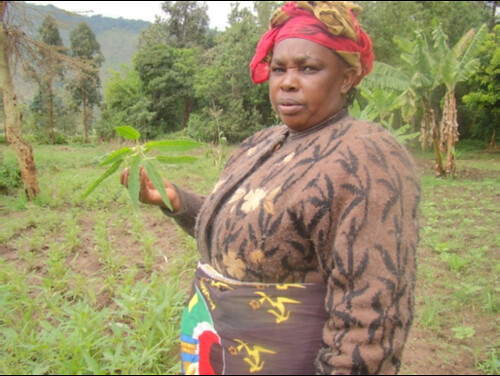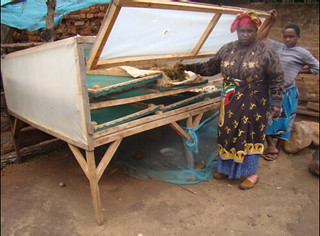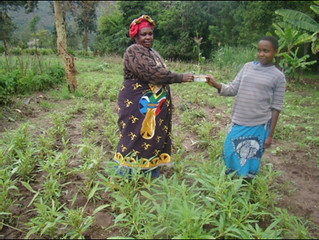Turning over a new leaf: How Amaranth farming has transformed the life of a woman farmer in Tanzania

Ephraim Lukumay, a woman farmer in Bermi village, Dareda ward, Babati District of Tanzania, did not think too highly of amaranth a few years ago. ‘We did not know the nutritive importance of this vegetable,’ she says. Today she grows amaranth to consume at home and to sell to neighbours and at markets. She is a participant in the Africa RISING East and Southern Africa Project, an initiative to improve agricultural production knowledge and access to modern technologies, such as high performing vegetable varieties in the sub-region.
As part of the project, Lukumay and 70 other farmers learned good production, post-harvest practices and farm record-keeping skills during training sessions hosted by The World Vegetable Center (AVRDC) in September 2013. They were also given improved tomato, amaranth, African eggplant and sweet pepper seeds for planting as a means of ensuring that each farmer grasped the practical aspects of the training.
Currently, about 85% of the trained farmers are growing amaranth alongside tomato, African eggplant and sweet pepper. ‘Before we did not have good quality seeds, such as what we have now in our fields,’ says Lukumay. ‘We are not using any pesticide; the crop is fast-growing and very palatable. I grow amaranth in my home garden, and I am confident that I can now contribute some money to supplement the family income and reduce dependence on my husband to provide us with everything.
‘Madira 1’, the amaranth variety distributed by AVRDC, grows well in Bermi. ‘We can harvest for a long time by cutting the leaves—about six months if we manage it right,’ says Lukumay. She harvested amaranth from her 3 by 15 meters plot for over 10 weeks since the first week of October 2013. ‘The first harvest was by thinning; then I left the other plants in a spacing of about 20 by 30 centimetres and then continued to cut the leaves after every vegetative growth.’
Her family of five consumes about 0.5kg of amaranth every day, and she sells more than 10kg every week. ‘Many people like the amaranth variety we grow from AVRDC seed,’ she says. ‘It tastes good and it is very nutritious. Most of my customers are pregnant mothers and families with children under five. When they visit pre-natal clinics, the nurses tell them to eat more amaranth!’
Lukumay’s 13-year-old daughter, Nembris, is the family cashier. Nembris attends Dareda Secondary School in Babati. She assists her mother in the vegetable garden for one hour after school and about 2 hours on Saturdays. Nembris is the family accountant for all the income generated from Amaranth cultivation.
“We have TZS 20,000 (USD 11) cash in hand now,’ Nembris said. ‘When we began selling amaranth I didn’t keep records but now I do, and we have made TZS 50,000 in the last two and half months,’ she adds.
Lukumay acknowledges the immense value addition of the AVRDC organized trainings to her vegetable production skills. ‘This training made us aware of the benefits of amaranth,’ she said. ‘This crop is now very attractive to us farmers because of the income it generates, and the nutrition it provides.’


Written by Victor Affari-Sefa (World Vegetable Center – AVRDC)




